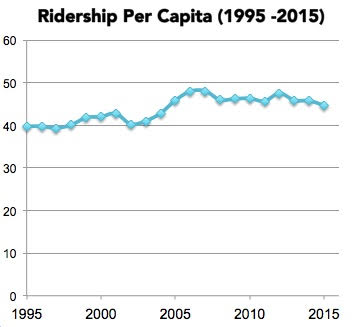Blog
Stop the VideoResearch Projects

We Need to Make Transit Part of Our Lives
Posted 2/4/2016 by METRANS

There are always questions about where you should slice data. The rail fans online have thrown a fit over the LA Times decision to begin in 1985, arguing that the numbers are misleading and that rail has been a success since 1995 in bringing people back to the system. If you look at the "ridership peak" graph (from the LA Times article), you’ll see that ridership has grown since 1995, not declined. Is that the right period to use to evaluate productivity? Or should we go all the way back to 1980 figures, which would make our current ridership look better than the 1985 beginning?

It might be more helpful to use ridership per capita. During the time period, LA County, which covers the most of Metro’s service area, also grew in population. Probably the best way to suss the numbers is via ridership per capita, which I have roughed out here. There has been growth since 1995; in 1995, we had about 40 trips per year per person living in LA County. in 2015, the number is up to 44 rides per person. We’ve spent approximately $20 billion on capital improvements during the entire time frame, and capital improvements are supposed to last. These up-front costs are meant to attract riders years and years into the future, long after the up-front costs have been paid.
It’s way beyond the scope of what I can write about in a blog post to test that claim. We’d like to know exactly how much those 4 additional trips per person cost us to get. But Metro as an agency has expanded tremendously from the 1986 time period onward, with each successive sales tax proposition that passes. Even since 2011, the agency’s budget has gone from around $3.9 billion to $5.6 billion, but that includes highway projects as well since the passage of Measure R.
So are the ridership numbers terrible? No, just…meh. Underwhelming, even if we start with 1995. The market share numbers, for just about every travel diary we run in Los Angeles, show that we aren’t moving the dial much in the old transit-versus-auto choice even if we are getting more trips. Trains cost quite a bit to build, just like everything in California is expensive to build, and if the rail advocates want a system, they have to convince other, less enthusiastic people that rail investment is super-duper, way worth the taxes collected. The promises can’t be small because the investments aren’t small, and as a result, transit capital projects get sold with a lot of hoopity doo and fanfare. We get promised the world with each new ballot box measure and list of investments. These are meant to clean up the environment! Make us thin! Clear up congestion! Whee!
And then, another train line opens, but it’s not world-changing. It’s nice, and useful to people who have access to it. Some new riders hop on, and some existing riders get somewhat better service. Traffic doesn’t get better, really; it only gets worse more slowly, and that’s the boring reality of most investment. The overpromise of budgetary politics often mismatches the slow ground game of incremental change in mobility services and urban environments.
Nonetheless, Angelenos have voted to support Metro and its activities in 3 out of 7 times out of the chute. They can be convinced to support the spending, and voters—and their representatives on the Metro Board—appear to support the system expansions. It’s hard for me to argue with democratic preferences.
In terms of alternative policy or planning solutions, we need to do much better with land use and station-area development. First of all, I think Metro is prevented by state law from acquiring land near stations except for Metro's immediate operational uses, and that means they are not allowed to buy up land for joint development. That’s a dumb rule, for Metro and for some real estate submarkets, because Metro is in a better position to take on land development risk than private developers in certain parts of the region.
Secondly, I think the Federal Transit Administration (FTA) needs to start getting tougher with its allocations for new starts. FTA should refuse to fund projects where the local city has not already increased allowed zoning densities and granted approvals around the proposed station areas. As it is, we have people who are demanding, and getting, $100+ million rail investments to serve their single-family suburban developments, and that’s no way to get good returns on capital investments.
And we really need to stop cutting bus service. There is no way that LA becomes a train-only market. The "last mile" problem is significant in most markets, not just in LA, and the idea that we can build up our trains and starve our buses simply dooms us to lose passengers because LA’s geographically distributed employment means that most transit commutes are likely to involve a modal transfer. If that transfer is awful, transit loses that trip to another mode.
I do think Metro could do more with running specials and ‘ride free’ days and using specials to pique interest. For example, we are having a free museum day this weekend. It could also be "free ride to free museum day."
Metro also needs to do better in working with employers and with other institutions. For instance, Metro did absolutely nothing when USC discontinued its support for transit riders. Regardless of whether USC’s transit subsidy program attracted many riders, it was a signaling and leadership moment when USC axed its program. Metro’s leaders didn’t say "boo" in response. The LA DOT didn’t say "boo." For all the prancing around our Mayor and other state Democrats do about alternative transportation, they did diddly to stand up to USC. When one of the region’s largest employers kicks transit support to the curb, agencies like Metro and the DOT, and our Mayor, need to show leadership, set the tone, and say "Hey, wait a minute. We know this program costs you money, but we’re trying to accomplish something here; we’re trying to build transit as a way of life in this city. Why are you bugging out on us?" That episode is so discouraging because it shows how much LA’s elected leadership wants to dig into taxpayers’ pockets at sales tax time to make sure the pretty trains get built, but how little real political capital our politicians wield in helping riders ride the pretty trains once they actually get built.
And finally, if Angelenos want transit to work, they have to do more than just add a few pennies to their sales taxes and cut ribbons in front of new trains. They have to get on the system and make it a part of their lives. I don’t think it’s possible that transit can outcompete the car until the auto environment gets really miserable, and LA is a long way from that. People don’t have to give up their cars to make a difference; taking transit a couple times a week, for lunch, to get to work, to go on a weekend outing with the kids—those are small changes that can bring people onto the system. If it is going to be a public system, the public has to be on it. Taking transit is a virtue. It’s good for the city. And it’s good for public life. And yeah, it’s probably going to take extra time, you’ll have to walk a bit, and chances are, you’ll associate with people you wouldn’t normally. Suck it up and get on the buses and trains if you want better numbers here. It’s on Metro, but it’s also on all of us, too, to make the system we’ve been building into what it could be.
Lisa Schweitzer
Lisa Schweitzer is Associate Professor at the USC Sol Price School of Public Policy. She specializes in urban studies, and, in particular, analyses of social justice, environment and transport. Her recent projects evaluate the distribution of social and economic opportunities and the location of environmental hazards. She blogs at lisaschweitzer.com.















